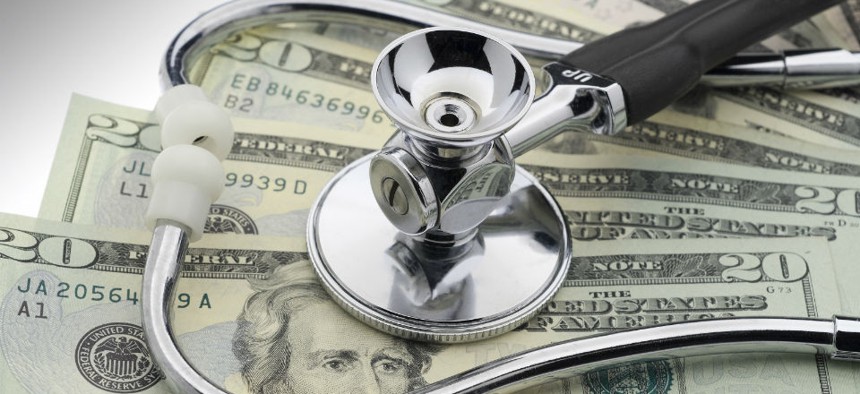
Christian Delbert / Shutterstock.com
Feds Will Pay 3.8 Percent More Toward Health Care Premiums in 2015
Postal employees' contributions will go up significantly more.
Federal employees and retirees will pay an average of 3.8 percent more toward their health insurance premiums in 2015, the Office of Personnel Management announced Tuesday.
Federal Employees Health Benefits Program enrollees with self-only coverage will contribute an average of $2.93 more per paycheck, while those with family coverage will pay about $6.89 more.
The increase is steeper than the rise in the government’s portion of the premiums, which will go up 3 percent. The employee share is increasing faster because employees are choosing better plans that require more out-of-pocket costs. Overall, the government pays about 70 percent of employees’ premiums.
Postal employees will face much more dramatic increases, and will contribute an average of 18.7 percent more toward their premiums next year. The government contributions will decrease an average of 0.9 percent. OPM officials said the bargaining process has caused the employee share to go up.
Overall premiums for non-postal employees, including both the employee and government portions, will increase by 3.2 percent. That is down from last year when they jumped 3.7 percent. OPM officials were satisfied with the figures, noting 2015 will mark the fourth consecutive year in which the increase was below 4 percent -- the longest such streak since the mid-1990s.
“We generally feel we are in the low end of the industry average,” said John Foley, OPM’s director of Planning and Policy Analysis. He added private-sector estimates showed a 3 percent to 6.5 percent increase for premiums next year.
OPM officials pointed to positive market trends and the effects of the Affordable Care Act as responsible for the relatively low rate hikes. Federal employees and retirees had to pay an additional 4.4 percent toward their premiums in 2014, while the government share went up 3.3 percent. In the three years prior to 2012, premiums went up overall by more than 7 percent annually. Still, federal employee advocates were not satisfied with the 2015 rates.
“The health insurance premium increase will take another bite out of the already diminished paychecks of middle-class federal employees across the country,” said Joseph Beaudoin, president of the National Active and Retired Federal Employees Association. “While the 3.2 percent increase in health insurance premiums is in line with the private sector, any increase means reduced take-home pay for federal employees, who, at most, will receive a 1 percent pay raise next year.”
This year’s exact increase will vary from plan to plan. The most popular plan -- the Blue Cross and Blue Shield Standard Option -- will see a $3.21, or 3.7 percent, increase for self-only enrollees per paycheck; family enrollees in the plan will pay an extra $8.33, or 4.1 percent, per paycheck. Forty percent of FEHBP participants are enrolled in that plan.
Premiums in the Federal Employees Dental and Vision Insurance Program will have more favorable numbers for feds, with dental rates increasing an average of 1.7 percent and vision premiums increasing an average of 1.5 percent compared to 2014.
Enrollees in the federal flexible savings account plan will for the first time have the option to carry over up to $500 into 2016. They will no longer have the grace period through March 15 to spend the money in their own accounts, though they still have the option for their dependents. The minimum contribution will be lowered to $100, while the maximum will be $2,500.
In March, OPM sent out a call letter to insurers to kick off premium negotiations, asking providers to focus on prescription drug costs, compliance with ACA and wellness programs.
FEHBP will offer a total of 257 plans in 2015, one more than it offered in 2014. Four of the plans are new offerings, while 11 will be offered to all FEHBP participants.
Open Season, the period in which federal employees and retirees can enroll in FEHBP or switch plans, will run from Nov. 10 through Dec. 8. Between 4 percent and 7 percent of enrollees typically switch plans annually.
(Image via Christian Delbert / Shutterstock.com)
NEXT STORY: The Time Feds Spend on Union Biz Inches Up







